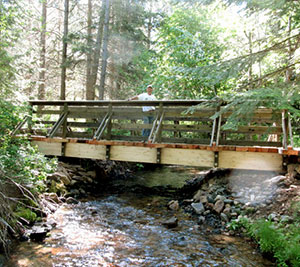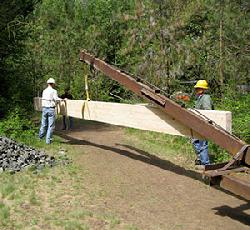|
||||
|
Parting Shots: Trail users pitch in to build bridge
9/26/2013 5:00:40 PM
 Photo courtesy of Bill Clark Loren Melcher pauses on the finished bridge. |
By Ken Carmichael
Splash Guest Column
At more than 3,000 acres, Liberty Lake County Park is one of the great places to ride horses. The Inland Empire Chapter of Back Country Horsemen (IEBCH) has been active for many years clearing trails in the park. Several years ago, IEBCH built an equestrian trailhead in order to separate the horses from off-road vehicles.
Over the past few years, the park's Edith Hansen trail has been flooded due to beaver dams raising the water level on wetlands near the trail. Several options were discussed, including boardwalks, and it was decided to move the trail to higher ground.
Spokane County Parks applied for a Recreation Conservation Office (RCO) grant and called on stakeholders to help remedy the situation. The Washington Trails Association (WTA) took the lead to reroute the trail, which required some blasting of rocks. The reroute required a bridge across a major stream. This is where IEBCH stepped in with labor, financing and expertise.
Ken Elliott, an IEBCH member, worked closely with county engineers to design a multi-use bridge capable of supporting horses. After a lengthy process of permitting and a culture resource survey, the bridge was started in 2012 with several IEBCH work parties preparing the trail approach and site, then pouring the concrete foundation. Because we were working around and over a stream, Ken had to design and build special equipment to pour the concrete.
He worked closely with Spokane County planners to purchase the bridge materials, some requiring custom design. Because of the terrain, a method was needed to get the two 26-foot beams to the bridge site. Ken designed and built a special trailer that could haul the beams and other materials over the trail to the site (it took two trips), then the trailer was disassembled and used to lift the beams across the stream using a large wheel loader rented by IEBCH.
The next day, a large IEBCH crew was assembled, with many skilled laborers, tools and equipment to do the final construction of the bridge. All told, more than 25 IEBCH members and guests contributed to the bridge construction.
The $36,860 RCO grant was possible because of the large contributions by WTA and IEBCH. The SCOPE Mounted Patrol and Trail Markers made additional contributions. The IEBCH performed more than 660 hours of labor and contributed more than $2,700 toward the cost of the bridge. Throughout the process, Spokane County provided excellent help with additional heavy equipment, materials, design and administrative support.
The county plans call for interpretative signage about the beaver ecology and history of the wetlands. There will also be trail signage for directions and mileage and recognition for the support provided by the various groups.
Ken Carmichael is a board member of the Inland Empire Chapter of Back Country Horseman.



